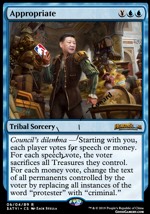The Power Nine Story: The Myr
It’s finally time for some vintage again. You’ve travelled several hundreds, if not thousands, of miles by car to get here. When you finally slump down into the quite uncomfortable chair besides the table, the stiff plastic texture of the seat makes you painfully and literally remember every travelled bump in the road. But this is the moment you’ve been waiting for. Your hands eagerly move to open your backpack and bring out a large book on the table, inconspicuously named ‘The New English Dictionary’.
As you open it, you reveal a hidden safe inside the book, with a deck box inside, to the empty room around you. Inside that deck box is a pile of 75 carefully double-sleeved playing cards. Even though your deck is partially white-bordered, there’s something special about shuffling it. It is after all a $5000 deck; you make sure to take your time and to be more careful than usual. Besides, any card could be a power nine card, and those nine cards alone make out more than two thirds of your deck’s value. Don’t screw this up now. It’ll end in 0-4, drop, beer, of course, but for now let’s focus on winning. It looks like 7 or 8 other people have arrived with legal decks, so let’s get this show on the road.
Playing vintage can be almost be a religious experience, and today we’re revisiting the mid-nineties to tell the story of the most powerful cards ever printed in Magic. These are, of course, the power nine: the powerful mana artifact Gilded Lotus, the winning draw spell Thoughtcast, the turn-tabler Time Warp, the five ultra-speed mana sources Gold Myr, Silver Myr, Leaden Myr, Iron Myr, Copper Myr and the complete game-changer Worldslayer. In this first article, we will focus on telling the story of the Myr.


Originally printed in the first Magic set ever, back in 1993, it is obvious that Richard Garfield had no idea as to what he was doing when he designed these cards. Not only do these artifacts produce mana, they walk and fight!


The Myr are also the first example of mana fixing artifacts, where you take colorless mana as input and are able to produce colored mana as output. This invention alone made the Myr sought-after gemstones, with Silver Myr reaching nearly $100 as early as 1995.

The splendid artwork by Kev Walker, at the time under the fictitious alias ‘xerent’, has accumulated much affection over the years. Walker later returned to depict the less-appreciated Moxen common artifact cycle in the Mirrodin set, printed in 2003. (The artwork for that cycle featured silly robots without googly eyes over weird backdrops, and it never gained much attraction.)











